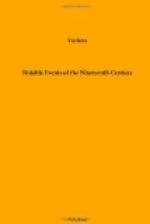Within two weeks the field in the South was cleared, and the Prussian army was turned upon Austria. King William’s forces numbered 260,000 men. They were commanded by the Crown Prince, Prince Frederick Charles, Von Moltke, Von Roon and General Bittenfeld. The King in person and Bismarck were present with the advance. The impact was more than Austria could stand. On the twenty-seventh and twenty-ninth of June, Frederick Charles defeated the Austrian advance in four indecisive engagements. Count Clam-Gallas, the Austrian general, was obliged to fall back on the main body for support.
In these same days the Crown Prince gained several preliminary successes over the principal Austrian army under Benedek. Then, on the river Bistritz, on the sixth of July, came the great battle of Sadowa. The opposing commanders in the beginning of the engagement were Frederick Charles and Benedek. The battle began at eight in the morning, and raged with the utmost fury until two in the afternoon. Thus far the Prussians had gained but little advantage; but at that hour the powerful division of the Crown Prince, which, like that of Bluecher at Waterloo, had been delayed by recent rains, appeared on the Austrian right. The wing of Benedek’s army was soon turned. Bittenfeld then broke the left, and under a general advance of the Prussian lines the Austrian centre gave way in confusion. The field was quickly swept. The overthrow of the Austrian army became a ruinous rout, and the out-flashing sun of evening looked upon a demoralized and flying host, scattering in all directions before the victorious charges of the Prussian cavalry.
The overwhelming victory of the Prussians was not without its rational causes. Indeed the antecedents of victory may always be found if all the facts of battle are known and analyzed. It remained for the battle of Sadowa to demonstrate practically the superiority of the needle-gun. This arm had been adopted by the Prussian government and was now for the first time on a great scale brought to the crucial test. Hitherto the old plan of muzzle-loading had been followed by all the nations of Europe and America. In our country the Civil War had come almost to its climax before breech-loading was generally introduced. Austria had continued to use the old muzzle-loading muskets. It seems surprising that nations, of whom intelligence and self-interest may well be predicated, should continue in such a matter as war to employ inefficient weaponry long after a superior arm has been invented.
If one might have looked into the gunshop of M. Pauli at Paris in the year 1814, he might have seen a gunsmith, twenty-seven years of age, plying his trade under the patronage of Napoleon the Great. That gunsmith was Johann Nicholas Von. Dreyse, of Soemmerda, who presently became an inventor as well as a smith, and in 1824, having returned to his own country, he took a patent for a new percussion method in musketry.




